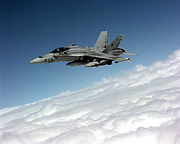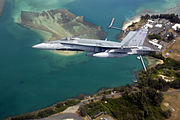Operational history
United States
Entry into service
McDonnell Douglas rolled out the first F/A-18A on 13 September 1978, in blue-on-white colors marked with "Navy" on the left and "Marines" on the right. Its first flight was on 18 November. In a break with tradition, the Navy pioneered the "principal site concept" with the F/A-18, where almost all testing was done at NAS Pax River, instead of near the site of manufacture, and involving Navy test pilots instead of contractor pilots much earlier in the process.
In March 1979, Lt Cdr John Padgett became the first Navy pilot to fly the F/A-18. In all, nine F/A-18As and two F/A-18Bs were assigned to flight systems development.
Following trials and operational testing by VX-4 and VX-5, Hornets began to fill the Fleet Replacement Squadrons (FRS) VFA-125, VFA-106, and VMFAT-101, where pilots are introduced to the F/A-18. The Hornet entered operational service with Marine Corps squadron VMFA-314 at MCAS El Toro on 7 January 1983, and with Navy squadron VFA-113 in March 1983, replacing F-4s and A-7Es, respectively.
The initial fleet reports were complimentary, indicating that the Hornet was extraordinarily reliable, a major change from its predecessor, the F-4J. Other squadrons that switched to F/A-18 are VFA-146 "Blue diamonds", and VFA-147 "Argonauts". In January 1985, the VFA-131 Wildcats moved from Naval Air Station Lemoore to Naval Air Station Cecil Field, Florida, and became the Atlantic Fleet’s first F/A-18 squadron.
The US Navy's Blue Angels aerobatic team switched to the F/A-18 Hornet in 1986, when it replaced the A-4 Skyhawk. The Blue Angels perform in F/A-18A and B models at air shows and other special events across the US and worldwide. Blue Angels pilots must have 1,350 hours and an aircraft carrier certification. The two-seat B model is typically used to give rides to VIPs, but can also fill in for other aircraft in the squadron in a normal show if the need arises.
Into combat
The F/A-18 first saw combat action in April 1986, when VFA-131 Hornets from USS Coral Sea flew SEAD missions against Libyan air defenses during Operation Prairie Fire and an attack on Benghazi as part of Operation El Dorado Canyon.
During the first Gulf War, two U.S. Navy F/A-18s were destroyed with the loss of their pilots. On 17 January 1991, the first day of the war, Lieutenant Commander Scott Speicher of VFA-81 was shot down and remains listed as missing in action. The other F/A-18, piloted by Lieutenant Robert Dwyer (who was officially listed as killed in action), was lost over the North Persian Gulf after a successful mission to Iraq.
F/A-18 pilots were credited with two kills during the Gulf War, both MiG-21s. On the first day of the war, U.S. Navy pilots Lieutenant Nick Mongilio and Lieutenant Commander (now Rear Admiral) Mark Fox were sent from the USS Saratoga in the Red Sea to bomb an airfield in southwestern Iraq. While en route, they were warned by an E-2C of approaching MiG-21 aircraft. The Hornets shot down two MiGs and resumed their bombing run, each carrying four 2,000 lb bombs, before returning to Saratoga. Mongilio and Fox become the first pilots to register air-to-air kills while still completing their original air-to-ground mission. The Hornet's survivability was demonstrated when a Hornet took hits in both engines and flew 125 mi (201 km) back to base. It was repaired and flying within a few days. Overall during the Gulf War, F/A-18s flew 4,551 sorties with ten Hornets damaged including the two losses previously mentioned.
As the A-6 Intruder was retired in the 1990s, its role was filled by the F/A-18. The F/A-18 demonstrated its versatility and reliability during Operation Desert Storm, shooting down enemy fighters and subsequently bombing enemy targets with the same aircraft on the same mission. It broke records for tactical aircraft in availability, reliability, and maintainability.
Both U.S. Navy F/A-18A/C models and Marine F/A-18A/C/D models were used continuously in Operation Southern Watch and over Bosnia and Kosovo in the 1990s. U.S. Navy Hornets flew in Operation Enduring Freedom from carriers operating in the North Arabian Sea. Both the F/A-18A/C and newer F/A-18E/F variants were used in Operation Iraqi Freedom, operating from aircraft carriers. Later in the conflict USMC A+, C, and primarily D models operated from bases within Iraq. An F/A-18C was accidentally downed in a friendly fire incident by a Patriot missile early in the conflict, and two others collided over Iraq in May 2005. In January 2007, two Navy F/A-18E/F Super Hornets collided in mid-air and crashed in the Persian Gulf.
Non-US service
Though Navy aircraft have not historically sold well on the export market, the F/A-18 has been purchased and is in operation with a number of foreign air services. Export Hornets are typically similar to U.S. models of a similar manufacture date. Since none of the customers operate aircraft carriers, all export models have been sold without the automatic carrier landing system, and Royal Australian Air Force further removed the catapult attachment on the nose gear. Except for Canada, all export customers purchased their Hornets through the U.S. Navy, via the U.S. Foreign Military Sales (FMS) Program, where the Navy acts as the purchasing manager but incurs no financial gain or loss. Canada ordered its planes directly from the manufacturer.
Australia
The Royal Australian Air Force purchased 57 F/A-18A fighters and 18 F/A-18B two-seat trainers, with 71 in service, and 4 lost to crashes. The first F/A-18 was delivered to the RAAF on 29 October 1984. The fleet is expected to be retired by 2015, replaced by the F-35 Lightning II.
Three options were considered for the replacement of the RAAF's Mirage IIIs, options were the F-15A Eagle, F-16 Falcon, and the then brand new F/A-18 Hornet. The F-15 was discounted because the version offered did not have a ground-attack capability. The F-16 was deemed unsuitable largely on the basis of its having only one engine. Consequently, Australia signed a contract in October 1981. The first two aircraft were produced in the US, with the remainder being assembled in Australia at GAF. Deliveries took place between February 1985 and May 1990. Original differences between the Australian and US Navy's standard F/A-18 were:
- the deletion of the nose wheel tie bar (used to engage the steam catapults on aircraft carriers)
- the addition of a high frequency radio
- an Australian fatigue data analysis system
- an improved video and voice recorder
- a different seat harness, and
- the use of ILS/VOR (Instrument Landing System/Very High Frequency Omnidirectional Range) instead of the carrier landing system.
In 2001, Australia deployed four aircraft to Diego Garcia, in an air defense role, during coalition operations against the Taliban in Afghanistan. In 2003, 75 Squadron deployed 14 F/A-18s to Qatar as part of Operation Falconer and these aircraft saw action during the invasion of Iraq.
Canada
Canada was the first export customer for the Hornet, replacing the CF-104 Starfighter (air reconnasissance & strike), the CF-101 Voodoo (air interception) and the CF-116 Freedom Fighter (ground attack). The Canadian Forces Air Command ordered 98 A-models (Canadian designation CF-188A/CF-18A) and 40 B models (designation CF-188B/CF-18B).
In 1991, Canada committed 26 CF-18s to the Gulf War, based in Qatar. In June 1999, with 18 CF-18s were deployed to Aviano AB, Italy, and they participated in both the air-to-ground and air-to-air roles in the former Yugoslavia.
The fighters are undergoing an avionics and structural upgrade program to extend service to 2020, upgrading F-18A and F-18B to F/A-18C and D standard. A total of 80 CF-18s, consisting of 62 single-seat and 18 dual-seat models were selected from the fleet for the upgrade program. As of 2003, Canada has 123 in service with 15 losses.
Finland
The Finnish Air Force (Suomen Ilmavoimat) ordered 64 F-18C/Ds. Delivery started on 7 June 1995. The Hornet replaced the MiG-21bis and Saab 35 Draken in Finnish service. One fighter was destroyed in a mid-air collision in 2001. Another damaged F-18C has been rebuilt into a F-18D. In order to do so, a forward section of a Canadian CF-18B was purchased and incorporated into the jet.
The Finnish F-18C includes the ASPJ (Airborne-Self-Protection-Jammer) jamming pod ALQ-165 that was canceled on original US Navy orders. The US Navy later included the ALQ-165 on their Super Hornet (F-18E/F) procurement. The Finnish Hornets were initially to be used only for air defense, hence the designation F-18.
Finland is upgrading its fleet of F-18s with new avionics, including helmet mounted sights (HMS), new cockpit displays, sensors and standard NATO data link. A number of the 63 Hornets remaining are going to be fitted to carry air-to-ground ordnance such as the AGM-154C JSOW, in effect returning to the original F/A-18 multi-role configuration. The upgrade includes also the procurement and integration of new AIM-9X Sidewinder and AIM-120C-7 AMRAAM air-to-air missiles. This Mid-Life Upgrade (MLU) is estimated to cost between €1-1.6 billion and work is scheduled to be finished by 2015. After the upgrades the planes are to remain in active service until 2020-2025.
Kuwait
The Kuwait Air Force (Al Quwwat Aj Jawwaiya Al Kuwaitiya)] has 39 F/A-18C and F/A-18D Hornets as of 2008. These aircraft were pre-ordered before the Iraqi invasion of August 1990. Delivery of the fighters started on 8 October 1991. The F/A-18C/Ds replaced A-4KU Skyhawk.
Malaysia
The Royal Malaysian Air Force (Tentera Udara Diraja Malaysia) has eight F/A-18Ds. The air force split their order between the F/A-18 and the Mikoyan MiG-29.
Spain

The Spanish Air Force (Ejército del Aire) ordered 60 EF-18A model and 12 EF-18B model Hornets (the "E" standing for "España", Spain), named respectively as C.15 and CE.15 by Spanish AF. Delivery of the Spanish version started on 22 November 1985. Currently all of these planes have been upgraded to F-18A+/B+ standard, close to F/A-18C/D (plus version includes later mission and armament computers, databuses, data-storage set, new wiring, pylon modifications and software, new capabilities as AN/AAS-38B NITE Hawk targeting FLIR pods).
In 1995 Spain obtained 24 ex-USN F/A-18A Hornets, with six more on option. The first six were delivered in December 1995. Prior to delivery, they were modified with F404 engines and other Spanish-specified modifications. This was the first sale of USN surplus Hornets.
Spanish Hornets operate as an all-weather interceptor 60% of the time and as an all-weather day/night attack airplane for the remainder. In case of war, each of the front-line squadrons would take a primary role: 121 is tasked with tactical air support and maritime operations; 151 and 122 are assigned to all-weather interception and air combat roles; and 152 is assigned the SEAD mission. Air refueling is provided by KC-130Hs and Boeing 707TTs. Pilot conversion to EF-18 is centralized in 153 Squadron (Ala 15). Squadron 462's role is air defense of Canary Island, being responsible for fighter and attack missions from Gando AB.
Six of the Spanish Hornets have been lost. Spanish Air Force EF-18s Hornet have flown Ground Attack, SEAD, CAP combat missions in Bosnia and Kosovo, under NATO command, in Aviano detachment (Italy). They shared the base with Canadian and USMC F/A-18s.
Switzerland
Switzerland's Luftwaffe purchased 26 C models and 8 D models. One D model was lost in a crash. Delivery of the aircraft started on 25 January 1996.
In late 2007 Switzerland requested to be included in F/A-18C/D Upgrade 25 Program, in order to extend the useful life of its F/A-18C/Ds. The program includes significant upgrades to the avionics and mission computer, 20 ATFLIR surveillance and targeting pods, and 44 sets of AN/ALR-67v3 ECM equipment. Switzerland is interested in acquiring 8-11 more F/A-18 Hornets to replace retired Mirages. In October 2008 the Swiss Hornet fleet reached the 50,000 flight hour milestone.




